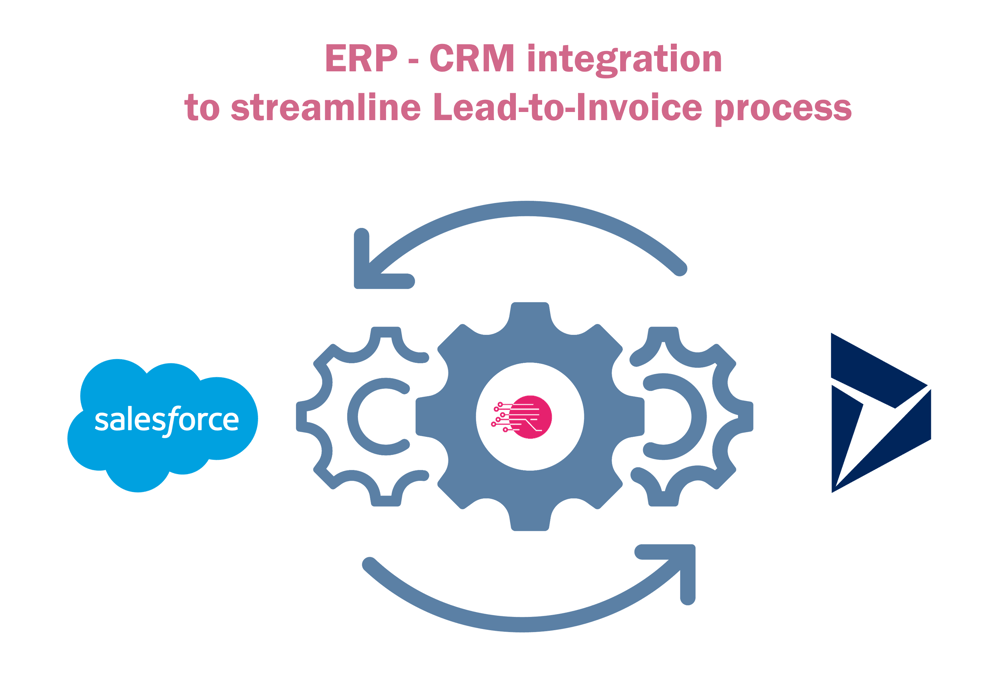Integrating ERP and CRM can come in many flavours. Most of these have one common goal: helping companies streamline their business process. Data integration has become a widely used way to increase sales and order fulfillment efficiency.
System integration, for example ERP to Salesforce integration, can help optimize many processes. The most frequent request for process optimization is surely the lead to cash process.
There are many benefits to it. For example, you can avoid double entries and get complete sales history at your fingertips. You can achieve this without even having to switch between systems.
Often the best thing about ERP CRM integration is that your staff gains in efficiency. Also, you can cut on license costs as they do not need access to both systems.
This article will investigate how data can be transferred from one system to the other to automate vital existing processes.
LEAD TO INVOICE: DATA FLOW EXAMPLE
In this article, we will take a look at a typical sales process where a lead comes in and gets processed until it is sold, shipped and paid for.
Leads are typically created in a CRM system (for example, Salesforce offers a great lead handling process). Salesforce also supports sales management, project management and opportunity management functionality. As the sales process moves along, the lead in Salesforce is converted to an account, a contact, and an opportunity.
This is a very standard process in Salesforce Sales Cloud. What happens if you have integrated Salesforce with an ERP solution? Soon after the lead creation in Salesforce, you will need this information inside your ERP software solution.
Manually re-creating the lead information in another system is an error-prone and slippery path.

Lead to invoice process with RapidiOnline
To secure a perfect data flow between Salesforce CRM and an ERP solution such as Microsoft Dynamics 365 ERP is to connect them. There are many data integration tools that can process data and move data from system to system.
Choosing a Salesforce integration tool such as RapidiOnline will make your sales team more effective than ever. They will have the required information to close deals. Your Salesforce reports and dashboards will then include data that usually is not accessible from CRM as it is traditionally stored in ERP.
In that way, an integrated CRM ERP environment is very much a management software solution. RapidiOnline is an excellent solution for this. RapidiOnline allows you to improve your workflows. It supports the efforts of your sales reps and secures data accuracy and data consistency between systems.
The optimal lead to invoice data flow
Using a data integration solution such as RapidiOnline to connect Salesforce and Microsoft Dynamics is truly beneficial. The below copy block will explain how RapidiOnline makes the lead to invoice process as smooth and efficient as possible.
The below data flow diagram shows how lead data is transferred and evolves as the sales process goes. 
At a trigger point, for instance when the first quote is accepted, a transfer in RapidiOnline will create a customer, a contact and the order in the ERP system (for example Microsoft Dynamics). The integration will also ensure that, moving forward, the record stays in sync between the CRM and the ERP system.
There is now an open sales order in Microsoft Dynamics. As a result, the sales order is transferred back into Salesforce as a copy of the original sales order. It can be displayed under an opportunity or an account - or wherever it makes most sense.
Using RapidiOnline, you can also trigger additional workflows. For example, you can create a workflow to notify your back office to make a credit check on the new customer. You can also create a workflow to review the order before it’s released.

You can support any process that eases your order fulfillment handling.
Working with RapidiOnline, you can follow any changes to the order in Salesforce because it ensures that the systems stay in sync. When an order is invoiced, it also syncs from the ERP system to Salesforce. The sales order is then removed from the open sales orders in both systems and re-appears as a posted invoice.
When the customer pays the invoice, the payment is shown as a ledger entry. The integration enables you to follow the client’s balance and payment history directly in Salesforce. You do not have to switch systems anymore.
Payments are balanced out with the matching invoices, giving a really good customer overview. It also makes it possible to produce better and more accurate reports directly from CRM.
This might not be your exact process. RapidiOnline can adapt to any process and data transfer needs between Salesforce and Dynamics. The thing to remember is that, using system integration, you can remove all manual transfers or double data-entries. Getting rid of these time-consuming and error-prone processes is quite an improvement.
Last, bringing all relevant historical customer data into your Salesforce CRM system, you give your salespeople a 360-degree view of their customers. This empowers them to service your customers for better customer relationships.










